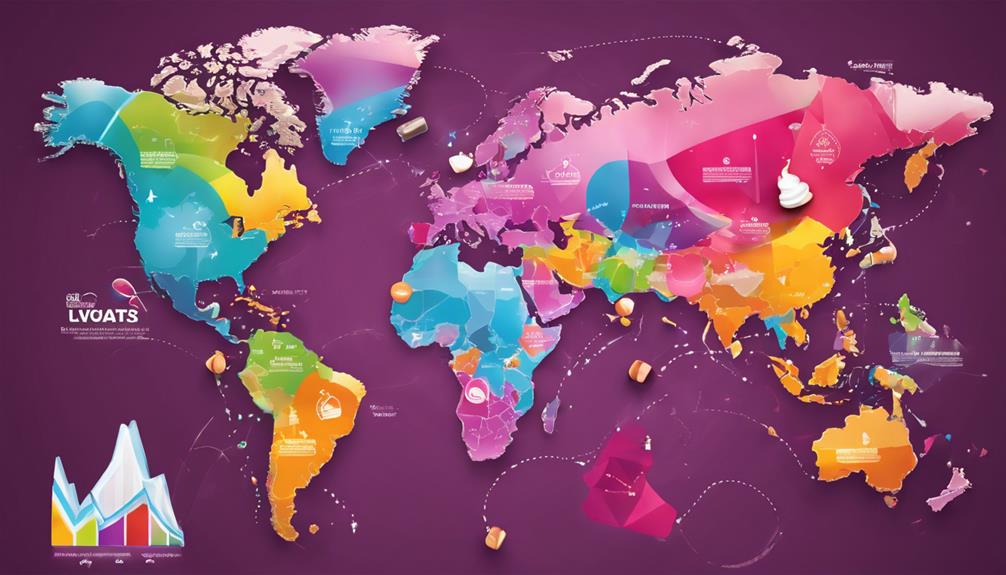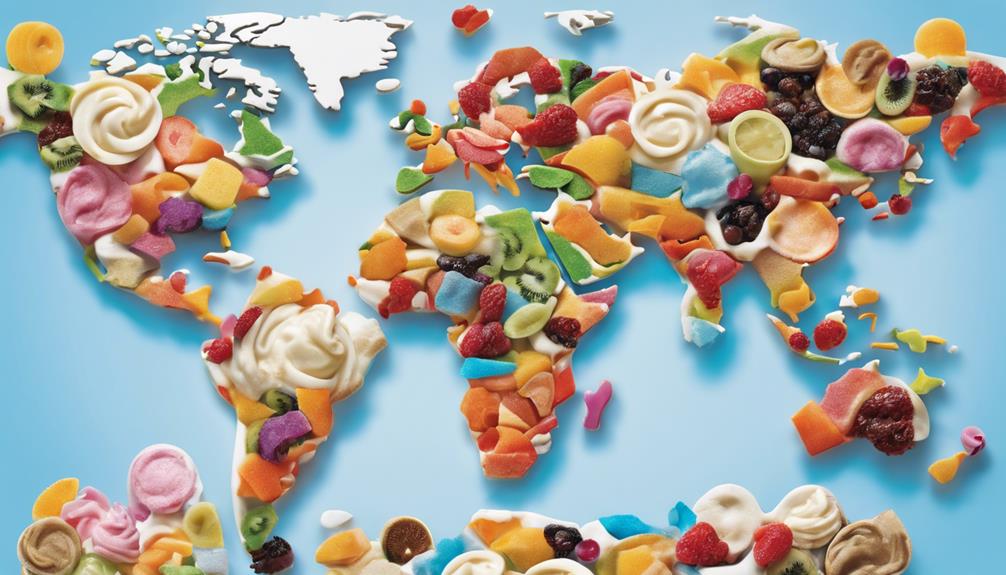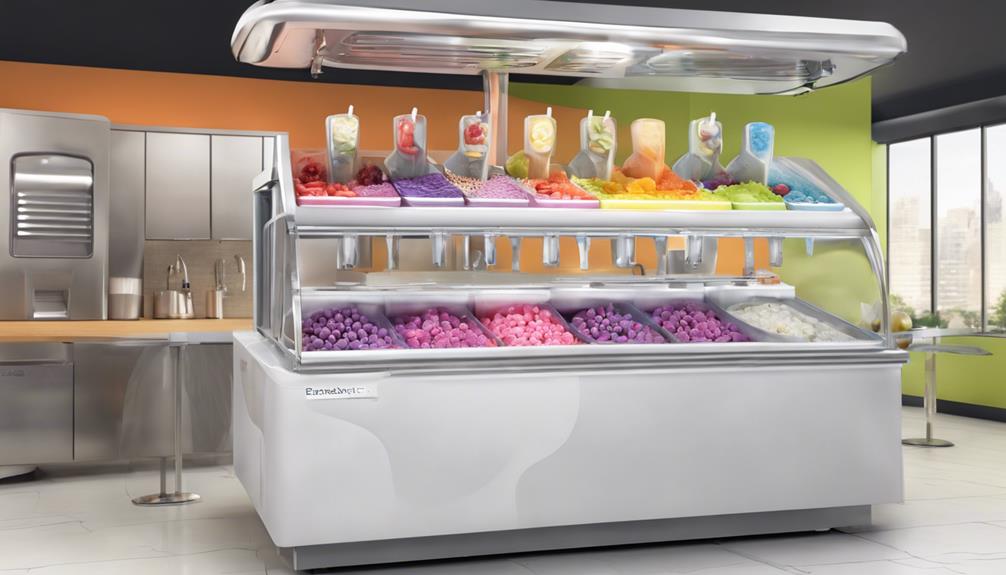You might have noticed frozen yogurt shops popping up in your neighborhood, and it's not just a local trend—this dessert's popularity is a global phenomenon. The appeal lies in its healthier profile compared to traditional ice cream, alongside increasing consumer interest in wellness and sustainability. Companies are innovating flavors and leveraging e-commerce to reach wider audiences. But what exactly drives this market's growth in different regions, and how are industry players adapting to diverse consumer preferences?
Key Takeaways
- The frozen yogurt market is projected to grow from USD 1.80 billion in 2023 to USD 2.46 billion by 2032.
- North America, dominated by global brands, leads the frozen yogurt market.
- Europe and Asia-Pacific are experiencing rapid growth with local companies challenging established brands.
- Popular flavors vary globally, with unique regional preferences like green tea in Asia-Pacific and rosewater in the Middle East.
- E-commerce platforms are significantly expanding the market reach of frozen yogurt worldwide.
Market Growth and Trends

Have you ever wondered how the global frozen yogurt market, valued at USD 1.80 billion in 2023, is projected to grow to USD 2.46 billion by 2032 at a CAGR of 3.53%? This significant market growth is driven by several key trends and factors. Consumer health consciousness is a major driver, as frozen yogurt is often perceived as a healthier alternative to traditional desserts. This aligns well with the industry's shift towards sustainability, with key players like Nestlé, Coca-Cola, Unilever, and Danone implementing eco-friendly practices in their production processes.
Innovations are also playing an essential role. Advances in technology have enabled the development of new flavors and healthier formulations, attracting a broader consumer base. E-commerce platforms have further amplified market reach, making it easier for consumers to access a variety of frozen yogurt products online. Partnerships and mergers among key players enhance market presence and adaptability to changing consumer preferences.
Regional Market Analysis
Building on the momentum of market growth and innovation trends, the frozen yogurt industry exhibits varied dynamics across different regions, with North America leading the charge driven by major players like Nestlé, Coca-Cola, and PepsiCo. In Europe, rapid growth is evident as companies like Unilever and Danone emphasize innovation and sustainability. Meanwhile, the Asia-Pacific region is expected to see substantial market growth, spearheaded by local companies pushing against established leaders.
Latin America, the Middle East, and Africa are also making strides, focusing on local tastes while integrating global trends. Each region navigates unique market landscapes to seize growth opportunities and expand their market presence.
| Region | Key Insights |
|---|---|
| North America | Market dominated by Nestlé, Coca-Cola, and PepsiCo; strong presence and innovation |
| Europe | Rapid growth driven by Unilever and Danone; focus on sustainability and innovation |
| Asia-Pacific | Significant growth expected; local companies challenging established market leaders |
| Latin America, Middle East, and Africa | Emphasis on local tastes; gradual adoption of global trends |
Understanding these regional market dynamics is essential to comprehending the global spread of frozen yogurt. By capitalizing on local preferences and market conditions, companies can effectively expand their reach and enhance their market share.
Popular Flavors Worldwide

Although taste preferences vary widely across regions, popular frozen yogurt flavors worldwide reflect both local traditions and global trends. In North America, you'll find classic options like chocolate, vanilla, and strawberry dominating the market. However, trendy flavors such as salted caramel and birthday cake are gaining traction, catering to those seeking invigorating dessert options.
In Europe, diverse taste preferences are evident with flavors like pistachio, hazelnut, and tiramisu. These choices resonate with traditional European ingredients, providing a sophisticated twist to frozen yogurt.
Asia-Pacific presents unique flavors like green tea, lychee, and taro, which integrate traditional ingredients into modern dessert trends. These flavors offer a revitalizing alternative to the more conventional options found elsewhere.
Middle Eastern countries bring a distinctive flavor profile to frozen yogurt with ingredients like rosewater, saffron, and pistachio, adding a Middle Eastern twist that's both exotic and familiar for local consumers.
Lastly, South America's frozen yogurt market highlights tropical fruit flavors such as passion fruit, mango, and coconut. These rich fruit offerings align perfectly with the region's abundant natural resources and the local palate's affinity for vibrant, fruity dessert options.
Key Market Drivers
When examining the key market drivers behind the global spread of frozen yogurt, you'll notice that health benefits play a substantial role, particularly with options that are low-fat and probiotic-rich. The diverse variety of flavors also contributes to its popularity, appealing to a wide range of taste preferences. Together, these factors have made frozen yogurt a preferred choice among health-conscious consumers and those seeking flavorful alternatives.
Health Benefits Appeal
Probiotics, lower calories, and essential nutrients like calcium and protein make frozen yogurt a compelling choice for health-conscious consumers, driving its global popularity. The inherent health benefits of frozen yogurt, such as being low-fat and packed with probiotics, can help maintain a balanced gut microbiome. This, coupled with its lower calorie count compared to traditional ice cream, positions frozen yogurt as a vital indulgence.
Health benefits of frozen yogurt are not just limited to probiotics and low calories. The presence of calcium and protein further enhances its appeal. Calcium is essential for bone health, while protein aids in muscle repair and growth. Consumers increasingly seek out immune-boosting foods, and frozen yogurt fits this demand due to its probiotic content.
| Key Component | Health Benefit | Consumer Appeal |
|---|---|---|
| Probiotics | Gut microbiome support | Immune-boosting |
| Low-fat | Reduced calorie intake | Vital indulgence |
| Calcium | Bone health | Essential nutrient |
| Protein | Muscle repair & growth | Nutritional support |
Rising awareness and preference for healthier dessert options are clear market drivers. Consumers are more informed and seek desserts that not only satisfy their sweet tooth but also contribute positively to their health. Frozen yogurt's nutrient profile and health benefits make it an appealing choice in the global market.
Diverse Flavors Variety
The frozen yogurt market's robust growth is largely driven by its diverse flavors, with popular choices like chocolate, strawberry, and mango capturing substantial market share. Specialty stores play a significant role by offering no-fat and low-fat variants, particularly appealing to health-conscious consumers in developed regions. These options contribute to market expansion as they align with the increasing demand for healthy alternatives.
The self-serve model, especially prevalent in North America, enhances consumer engagement by allowing them to choose from a wide range of flavors. This model not only attracts a diverse consumer base but also boosts sales through personalized experiences. In Europe, the market is further propelled by the introduction of plant-based frozen yogurt options, catering to the growing segment of consumers seeking dairy-free, healthy alternatives.
The global market size, valued at USD 1.80 billion in 2023, is projected to reach USD 2.46 billion by 2032. This growth is largely driven by the variety of flavors available, which keeps consumers returning for more. The continuous innovation in frozen yogurt flavors ensures that the market remains dynamic and responsive to evolving consumer preferences.
Major Industry Players

Leading the charge in the global frozen yogurt market, industry giants like Nestlé, Coca-Cola, PepsiCo, Unilever, Danone, and General Mills Inc. demonstrate dominance through their relentless focus on product innovation, sustainability, and extensive market presence. In the competitive landscape, these top companies leverage their vast resources to stay ahead of market trends and consumer preferences. An industry analysis reveals that North American frozen yogurt markets are mainly led by Nestlé, Coca-Cola, and PepsiCo, leveraging their established distribution networks and brand loyalty.
In Europe, Unilever and Danone are key players driving innovation with unique flavor profiles and health-conscious options. The Asia-Pacific region presents a dynamic scenario where local companies are increasingly challenging these market leaders by tailoring their products to regional tastes. Latin America, the Middle East, and Africa are also becoming significant markets, where companies focus on blending local flavors with global market strategies to attract diverse consumer bases.
These market trends highlight a global market where adaptability and innovation are essential. Each region's unique consumer demands shape the strategies of these major industry players, ensuring they remain at the forefront of the frozen yogurt industry.
Distribution Channels and Sales
Operating in the complex terrain of distribution channels and sales, frozen yogurt companies increasingly rely on online platforms and retail giants like Costco, Target, and Walmart to drive market penetration and revenue growth. Online sales channels, boosted by attractive offers and discounts, have emerged as a significant revenue source. This digital shift allows companies to tap into a broader customer base, catering to consumers who prefer the convenience of home delivery.
The retail market expansion for frozen yogurt is also evident in the proliferation of its products across hypermarkets, supermarkets, convenience stores, and discounters. These distribution channels ensure that frozen yogurt is accessible to a diverse demographic, amplifying its reach. For instance, major players like Menchies leverage these channels to enhance their market presence.
However, navigating these distribution channels requires strict adherence to regulatory compliance, especially concerning production standards and safety testing. This secures product integrity and consumer trust, which are vital for sustained growth. In the U.S., factors like low unemployment rates and stable electricity prices further bolster the retail market environment, facilitating easier distribution and storage.
Frequently Asked Questions
How Big Is the Frozen Yogurt Industry?
You're looking at a $1.80 billion industry in 2023, projected to hit $2.46 billion by 2032. Market trends show health benefits, consumer preferences, and flavor innovations driving growth. Major yogurt brands adapt pricing strategies in a competitive landscape.
Why Did Frozen Yogurt Become so Popular?
Back in the day, frozen yogurt's health benefits, unique flavors, and alignment with dietary trends made it popular. Social media, celebrity endorsements, cultural shifts, innovative marketing, and seasonal demand turned it into a guilt-free indulgence and dessert alternative.
How Big Is the Global Yogurt Market?
You'll find the global yogurt market is substantial, driven by market trends and consumer preferences. With industry growth, market segmentation, and regional markets, yogurt consumption rises due to health benefits, product innovation, and a competitive landscape led by market leaders.
What Is the Demographic of Frozen Yogurt?
You'll find that frozen yogurt's demographic spans various age groups, influenced by health trends, flavor preferences, and geographic differences. High-income urban areas, social media impact, dietary needs, cultural influences, seasonal trends, and marketing strategies drive consumption.
Conclusion
To conclude, the frozen yogurt market is flourishing, fueled by health trends and creative flavors. With a projected market value of USD 2.46 billion by 2032, there's no doubt that this industry is on a strong upward trajectory. Regional markets offer unique flavors and opportunities, making it essential for companies to adapt locally while thinking globally. If you're looking to invest in a growing market, frozen yogurt is definitely worth a closer look.







